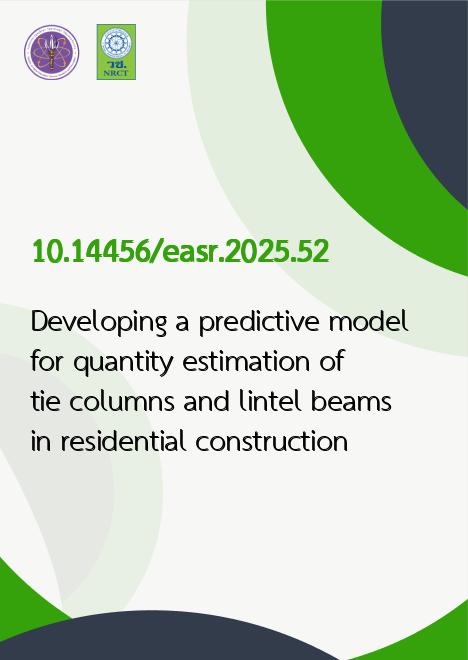
|
Developing a predictive model for quantity estimation of tie columns and lintel beams in residential construction |
|---|---|
| รหัสดีโอไอ | |
| Creator | Sunun Monkaew |
| Title | Developing a predictive model for quantity estimation of tie columns and lintel beams in residential construction |
| Contributor | Tanapat Namjan, Paisarn Suksoom, Chookiat Choosakul, Gritsada Sua-iam |
| Publisher | Faculty of Engineering, Khon Kaen University |
| Publication Year | 2568 |
| Journal Title | Engineering and Applied Science Research |
| Journal Vol. | 52 |
| Journal No. | 6 |
| Page no. | 572-583 |
| Keyword | Construction cost estimation, Tie column-lintel beam, Multiple Linear Regression, Residential buildings, Predictive modeling |
| URL Website | https://ph01.tci-thaijo.org/index.php/easr/index |
| Website title | Engineering and Applied Science Research |
| ISSN | 2539-6161 |
| Abstract | Accurate construction cost estimation is at the root of any effective project planning, yet it often requires extensive expertise and time-consuming calculations. This paper discusses a predictive equation for estimating the quantity of tie columns and lintel beams in a two-story residential building. In this study, multiple linear regression analysis was employed to identify the significant variables that impact the quantity of those structural elements using 75 sets of residential drawings, all of which featured conventional two-story brick masonry construction with reinforced concrete frames. The formulated equation, where Y represents the total linear meters of tie columns and lintel beams combined, is expressed as Y = 1.834 + 1.243 (brick wall area in m²) - 0.639 (open space area in m²). The equation was checked against fifteen residential designs with detailed estimates. The percentage error was observed to be between -3.58% and 5.37%, which is considered within an acceptable limit for preliminary estimates. This equation could provide a useful tool for cost estimators, offering a much-simplified approach yet yielding reasonable accuracy for preliminary assessments of the structural quantities of buildings. This research highlights the equation's potential for improving efficiency in project planning and cost estimation within its defined scope, with further validation across a wider range of designs recommended to broaden its applicability. |